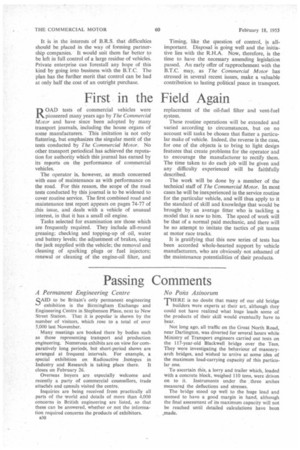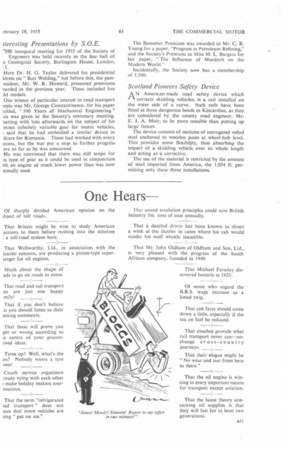Passing Comments
Page 38

Page 39

If you've noticed an error in this article please click here to report it so we can fix it.
A Permanent Engineering Centre
SAID to be Britain's only permanent engineering exhibition is the Birmingham Exchange and Engineering Centre in Stephenson Place, next to New Street Station. That it is popular is shown by the number of visitors, which rose to a total of over 5,000 last November.
Many meetings are booked there by bodies such as those representing transport and production engineering. Numerous exhibits are on view for cornparatively long periods, but short-period shows are arranged at frequent intervals. For example, a special exhibition on Radioactive isotopes in
Industry and Research is taking place there. It closes on February 26.
Overseas buyers are especially welcome and recently a party of commercial counsellors, trade attachds and consuls visited the centre.
Inquiries are being received from practically all parts of the world and details of more than 4,000 concerns in British engineering are listed, so that these can be answered, whether or not the information required concerns the products of exhibitors.
B30
No Pons Asinorum
THERE is no doubt that many of our old bridge I builders were experts at their art, although they could not have realized what huge loads some of the products of their skill would eventually have to bear.
Not long ago, all traffic on the Great North Road, near Darlington, was diverted for several hours while Ministry of Transport engineers carried out tests on the 117-year-old Blackwell bridge over the Tees. They were investigating the behaviour of masonryarch bridges, and wished to arrive at some idea of the maximum load-carrying capacity of this particular one.
To ascertain this, a lorry and trailer which, loaded with a concrete block, weighed 110 tons, were driven on to it. Instruments under the three arches measured the deflections and stresses.
The bridge stood up well to the huge load and seemed to have a good margin in hand, although the final assessment of its maximum capacity will not be reached until detailed calculations have been ,made.
7teresting Presentations by S.O.E.
HE inaugural meeting for 1955 of the Society of • Engineers was held recently in the fine hall of e Geological Society, Burlington House, London, Here Dr. H. G. Taylor delivered his presidential 'dress on "Butt Welding," but before this, the pastesident, Mr. W. R. Howard, presented premiums yarded in the previous year. These included five Ad medals.
One winner of particular interest to road transport :ople was Mr. George Constantinesco, for his paper aided, "100 Years of Mechanical Engineering." Us was given at the Society's centenary meeting. 'tatting with him afterwards on the subject of his mous infinitely variable gear for motor vehicles, ; said that he had embodied a similar device in Hears for Rumania. These had worked with every .ccess, but the war put a stop to further progress ere so far as he was concerned.
Be was convinced that there was still scope for is type of gear as it could be used in conjunction ith an engine of much lower power than was now =ally used.
The Bessemer Premium was awarded to Mr. C. R. Young for a paper, "Progress in Petroleum Refining," and the Society's Premium to Miss M. L. Burgess for her paper, "The Influence of Murdoch on the Modern World."
Incidentally, the Society now has a membership of 1,500.
Scotland Pioneers Safety Device
AN American-made road safety device which corrects skidding vehicles, is a rail installed on the outer side of a curve. Such rails have been fitted at three dangerous bends in Kincardine, as they are considered by the county road engineer, Mr. E. J. A. Moir, to be more sensible than putting up large fences.
The device consists of sections of corrugated rolled steel anchored to wooden posts at wheel-hub level. This provides some flexibitity, thus absorbing the impact of a skidding vehicle over its whole length and acting as a corrective.
The use of the material is restricted by the amount of steel imported from America, the 1,054 ft. permitting only these three installations.








































































































